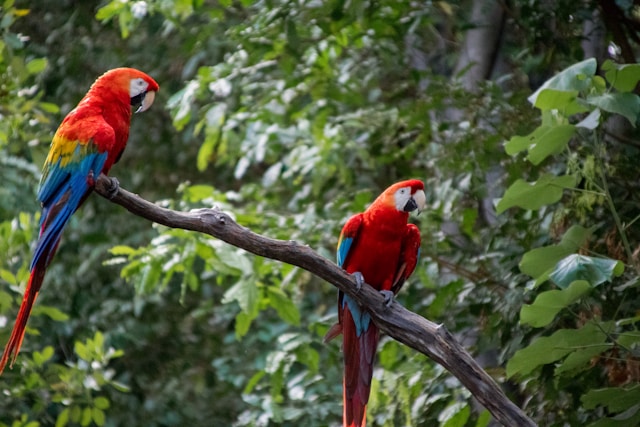Nestled within the lush tropical rainforests of Belize, the scarlet macaw stands out as a vibrant symbol of beauty and resilience. With its striking red, blue, and yellow plumage, this iconic bird captivates the imagination of all who encounter it. Beyond its stunning appearance, the scarlet macaw plays a crucial role in the ecosystem and holds significant cultural importance in Belize. In this article, we delve into the world of the scarlet macaw, exploring its unique characteristics, habitat, conservation efforts, and the profound impact it has on both wildlife enthusiasts and local communities.
An Introduction to the Scarlet Macaw’s Vibrant Plumage
The scarlet macaw’s vibrant plumage is a sight to behold, painting the skies of Belize with its stunning hues of red, blue, and yellow. This iconic bird’s appearance is not just for show; it serves essential functions in its life, from attracting mates to blending into its natural environment.
The vivid red feathers that adorn the scarlet macaw’s wings and tail are a result of carotenoid pigments found in its diet, primarily derived from fruits like the ripe berries of the annatto tree. These pigments not only give the macaw its signature red color but also serve as indicators of the bird’s health and fitness. A scarlet macaw with bright, glossy plumage is often seen as a prime candidate for mating, showcasing its vitality and ability to acquire quality food sources.
Complementing the red plumage are the deep blue feathers that adorn the macaw’s back and upper wings. These blues are created by microscopic structures in the feathers that refract light, producing an iridescent effect known as structural coloration. This iridescence adds depth and shimmer to the macaw’s appearance, especially noticeable during flight or when the bird is basking in sunlight.
Contrasting with the reds and blues are the vibrant yellow feathers on the macaw’s chest and underside of its wings. This yellow coloration serves multiple purposes, including camouflage in the dappled sunlight of the rainforest canopy and signaling to other macaws during social interactions.
Together, these colors create a mesmerizing display that not only showcases the scarlet macaw’s beauty but also reflects its adaptability and evolutionary prowess. As we delve deeper into the scarlet macaw’s world, we uncover not just a bird of stunning plumage but a marvel of nature’s artistry and ecological intricacies.
Habitat and Conservation Efforts in Belize’s Tropical Rainforests
The scarlet macaw’s vibrant presence is intricately tied to the lush tropical rainforests of Belize, where it finds its ideal habitat among towering trees and rich biodiversity. These forests provide the macaw with essential resources such as food, nesting sites, and protection from predators, making them crucial for the bird’s survival.
However, the scarlet macaw and its habitat face significant challenges due to human activities such as deforestation, habitat fragmentation, and illegal wildlife trade. Deforestation, driven by agriculture, logging, and infrastructure development, has led to the loss of large swathes of the macaw’s natural habitat, reducing the availability of food sources and suitable nesting sites.
To address these threats, conservation efforts in Belize focus on preserving and restoring the scarlet macaw’s habitat while combating illegal wildlife trade. Protected areas such as national parks and wildlife reserves play a vital role in safeguarding the macaw’s habitat, providing sanctuary for the birds to feed, nest, and raise their young without disturbance.
Furthermore, conservation organizations collaborate with local communities to promote sustainable land use practices that benefit both people and wildlife. Initiatives like reforestation projects, agroforestry programs, and eco-tourism ventures not only support the scarlet macaw’s habitat but also provide economic opportunities for communities living in and around the rainforests.
Education and awareness campaigns also play a crucial role in conservation efforts, highlighting the importance of preserving biodiversity and the role of the scarlet macaw as a flagship species for tropical rainforest conservation. By engaging stakeholders at all levels, from government agencies to local residents, Belize aims to ensure a sustainable future where the scarlet macaw continues to thrive in its natural habitat for generations to come.
Cultural Significance and Ecotourism Impact of the Scarlet Macaw
Beyond its ecological role, the scarlet macaw holds profound cultural significance in Belize, deeply intertwined with indigenous beliefs, traditions, and art forms. For many indigenous communities, the macaw is a symbol of strength, beauty, and spiritual connection to the natural world, reflected in ceremonial practices, storytelling, and artistic expressions.
The vibrant colors of the scarlet macaw’s plumage have inspired indigenous artisans for generations, influencing traditional crafts such as weaving, pottery, and painting. Macaw feathers were historically used in ceremonial attire and as symbols of status and honor, highlighting the bird’s importance in indigenous cultures.
Today, the scarlet macaw continues to play a central role in Belize’s cultural landscape, featured prominently in festivals, ceremonies, and local artwork. Its image adorns flags, banners, and murals, serving as a proud emblem of Belizean identity and environmental stewardship.
The presence of the scarlet macaw also fuels ecotourism initiatives in Belize, attracting visitors from around the world eager to witness these majestic birds in their natural habitat. Eco-lodges, guided birdwatching tours, and wildlife sanctuaries offer opportunities for travelers to experience the beauty of the macaw and learn about conservation efforts firsthand.
Ecotourism not only generates revenue for local communities but also promotes conservation awareness and sustainable practices. Visitors gain a deeper appreciation for the scarlet macaw’s role in the ecosystem and the importance of protecting its habitat for future generations.
However, balancing ecotourism with conservation challenges requires careful management to minimize disturbances to the macaw’s natural behaviors and habitats. Responsible tourism practices, guided by scientific research and community engagement, are essential to ensure that ecotourism benefits both local communities and the scarlet macaw’s long-term conservation.
Final Thoughts
The scarlet macaw stands as a symbol of resilience, beauty, and cultural heritage in Belize. Its vibrant plumage and ecological significance highlight the intricate balance between wildlife conservation, cultural traditions, and sustainable tourism practices.
As we reflect on the scarlet macaw’s journey through Belize’s tropical rainforests, it becomes clear that its survival is intertwined with the well-being of its habitat and the communities that coexist with it. Conservation efforts must continue to prioritize habitat protection, restoration, and anti-poaching measures to ensure the scarlet macaw’s continued presence in the wild.
Moreover, recognizing the macaw’s cultural significance reinforces the importance of indigenous knowledge and traditional practices in conservation strategies. By engaging with local communities and incorporating their perspectives into conservation initiatives, we foster a more holistic approach that respects both nature and culture.
Ecotourism, when managed responsibly, can contribute positively to conservation efforts by raising awareness, supporting local economies, and promoting sustainable practices. However, it is essential to strike a balance that minimizes ecological impacts and respects the macaw’s natural behaviors and habitats.
In conclusion, the scarlet macaw serves as a powerful ambassador for biodiversity conservation and cultural heritage preservation in Belize. Its presence reminds us of the interconnectedness of all life forms and the shared responsibility we have to protect and cherish our natural world for future generations to enjoy.




